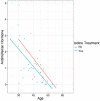Radioactive iodine and female fertility
- PMID: 35260614
- PMCID: PMC8904766
- DOI: 10.1038/s41598-022-07592-8
Radioactive iodine and female fertility
Abstract
Radioactive iodine (I131) is used after surgery in the treatment of Differentiated Thyroid Carcinoma (DTC). There is no solid evidence about the potential deleterious effect of I131 on women fertility. The objective of this study is to assess the impact that I131 may have on fertility in women. All women followed by DTC in our department have been analyzed and women younger than 45 years old at the time of diagnosis and initial treatment were included. There were 40 women exposed to I131 (study group) and 11 women who were only treated with thyroidectomy (control group). Of the women exposed to I131, 40% went through early menopause, while no cases were reported among their controls. Furthermore, 29.2% of women exposed to I131 had decreased Antimüllerian Hormone (AMH), compared to the only 11% of unexposed women (not significant). Regarding the fertility impairment "perceived" by patients, in the group of women exposed to iodine, 17.9% described being unable to complete their genesic desire whereas, none was registered in the control group. We conclude that radioactive iodine can affect a woman's fertility and shorten her reproductive life, so this is an aspect that should be taken into consideration.
© 2022. The Author(s).
Conflict of interest statement
The authors declare no competing interests.
Figures
References
-
- Tuttle RM, Ahuja S, Avram AM, et al. Controversies, consensus, and collaboration in the use of 131I therapy in differentiated thyroid cancer: A joint statement from the American thyroid association, the European association of nuclear medicine, the society of nuclear medicine and molecular imaging, and the European thyroid association. Thyroid. 2019;29(4):461–470. doi: 10.1089/thy.2018.0597. - DOI - PubMed



